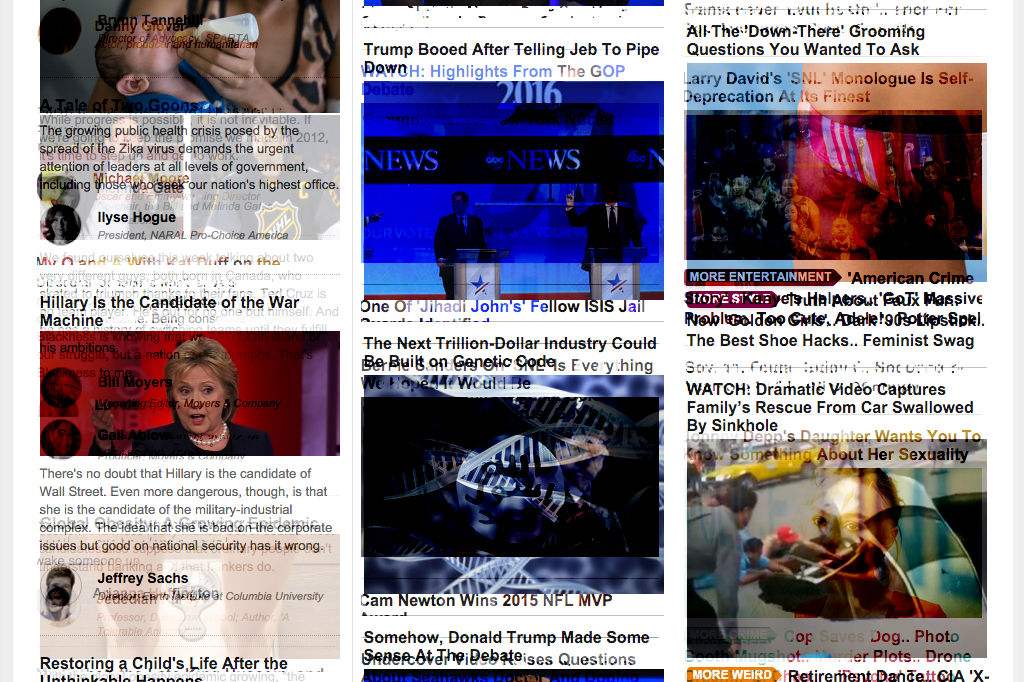
In February 2016, I gave a presentation for Sustainable UX: Digital Design vs. Climate Change, a conference about how content strategists, designers, developers, managers and site owners are addressing climate change. Thirteen different presenters spoke about their work, which included open source methodologies, creating a green content management system, and building sustainable behaviours and frameworks within teams.
I wrote a blog post called Online News is the Canary in the Coal Mine about my presentation. The talk focused the massive growth of online news and how news sites, because of code, feature and content bloat, are contributing to carbon emissions. Since then, I had the opportunity to connect with a number of other presenters and received great feedback about the talk, which you can watch here on YouTube.
I also had the presentation professionally transcribed so that folks who don’t like video, can’t see video, or have any accessibility issues, can access the content. YouTube has the ability to automatically transcribe content through closed captioning but I would much rather have it available in a blog post.
Here it is.
-—-
Thank you for having me. This is a real honour, and, like I said, a real pleasure to be here. I hope that what I’m about to say will kind of dovetail nicely with what James Christie has been talking about in his last conversation, and hopefully will dovetail nicely with the entire conversation today.
When I originally started working on this talk, I wanted to focus only on the online components of the news: the nuts and bolts of delivering content. But the deeper I dug, the more I become interested in the facts of how news and the media were generally growing and how media itself is developing. So, as always, context is everything.
As we know, news is critically important to functioning democracies and is one of the key facets and benefits of living in civil society. One of the first things, as we know, dictators and demagogues do when they get in office is to shut down the news in defence of the state, so we obviously want to empower the news. We also don’t want online news taking up more resources and more energy to power our consumption of content more than it needs to, so the cost of doing more and more news online are actually two things, privacy and energy usage. I’ll talk a little bit about these today during this conversation.
As you can see, the title of the talk is “Online News, The Canary in the Coal Mine.” My feeling is we need the canary to survive as we begin to shut down the coal mines.
The State of Print

We should just talk a little bit about the state of print in news because it will provide you a little bit broader context. As you probably know, there are a lot of daily newspapers being printed. Most of these are large, national, international in scope. According to readership data from Nielsen, 56% of those who consume a newspaper read it exclusively in print. A good portion of people read a newspaper both online and in print, and 5%, according to these statistics, read newspapers exclusively on mobile.
I looked up the largest daily newspapers by average circulation and according to International Federation of Audit Bureau of Circulations (quite a mouthful) the largest of print papers, Yomiuri Shinbun (I’m probably saying it wrong) is in Japan, which is 9.7 million print subscribers. This is followed by another one in Japan, Asahi Shimbun, with 7.5 million subscribers. The fifth largest print newspaper is Reference News in China with 3 million and the largest newspaper in the west is Bild in Germany at 2.6 million. The New York Times is number 18, surprisingly, at 1.9 million in subscribers.
Tough News
Interestingly, in most, if not all cases, circulation has increased slightly for large newspapers, so print isn’t going away quickly. But news is moving online faster and faster, and all of these print newspapers have very, very robust and very big news websites. Here’s the tough news, at least in terms of local newspapers. Local community newspapers are the ones that are really suffering. Here in Canada, we learned last week that Guelph Mercury in Ontario stopped publishing its last print newspaper on Friday. 26 jobs were lost. One of the reporters said, “We definitely lost an aspect and element of accountability”. The Guelph Mercury was around for 149 years.
On the very same day, the Nanaimo Daily News in British Columbia, Canada, stopped publishing. That paper was 141 years in business. 10 people lost their jobs. Then, back east again, the Toronto Star announced 2 weeks ago that they were closing their main printing plant, so the company spent $400 million on that plant in 1992 and the plant’s closing means 220 full-time and 65 part-time staff at the plant will lose their jobs. They’re also going to be cutting digitally focused positions in the newsroom.
While news is growing online, some people are discussing a new term for the closing of local newspapers, something called news poverty, where some communities don’t even know what’s happening in their own neighbourhood. In Canada right now, there are 16 companies that are running 102 local newspapers. Just to provide a little bit more context, there’s something called media consolidation, which I’m sure everybody here has heard about and knows about.
It’s not only happening for print newspapers—it’s happening very quickly online. Most of us here today probably are pretty internet savvy. We often think that the diversity of news we see online is strong and that we have in fact too many places to see and receive news. I usually feel that way.
Friends
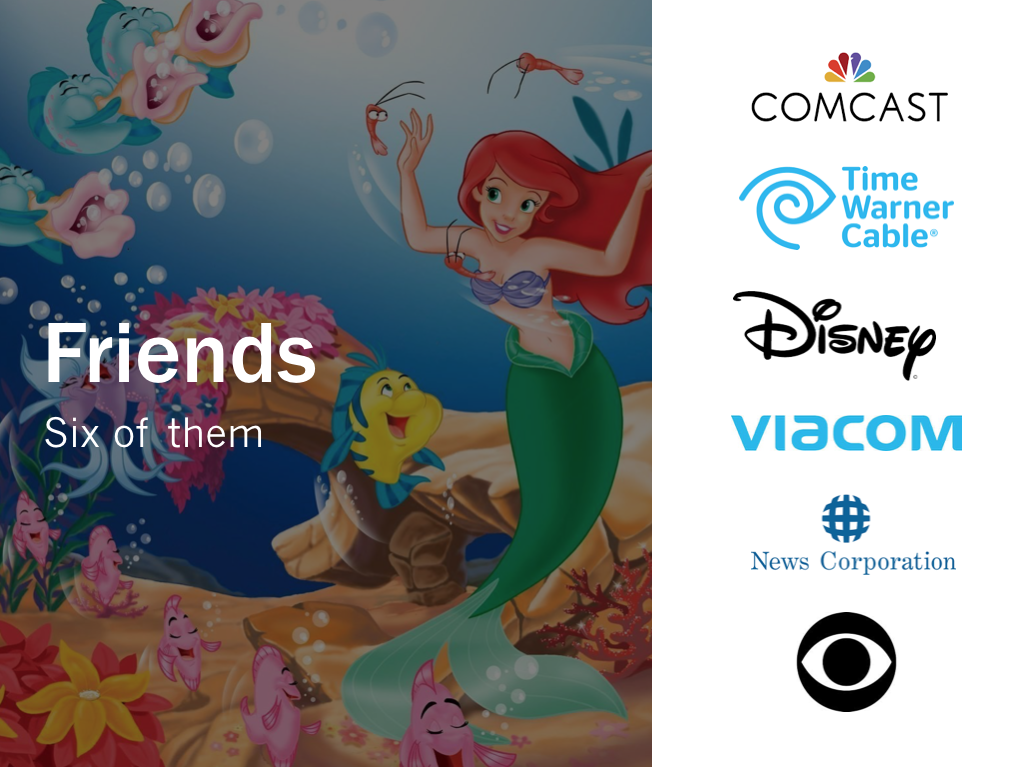
This is not really the case, at least when it comes to mainstream media. The largest media companies, at least ones in North America, have consolidated their operations and serve more people with fewer resources, and this is partly because it is less and less expensive to move a business online, and because news delivered online provides a lot of tools for companies to better understand their audiences. We’ll talk about that in a minute.
In 1983 (this is a really interesting statistic) 90% of U.S. media was controlled by 50 companies. 90%, 50 companies. Today, 90% is controlled by these 6 companies: Comcast, Time Warner, Disney, Viacom, News Corps and CBS.
Online Rules
While this all sounds very gloomy and doomy, I don’t mean it to be that way. Online news really is one of the best examples of the incredible embarrassment of riches that we, as a 21st century global culture, should be thankful for. Online news, whether it’s mainstream, alternative, local, national, football or goofball, is a pillar of civil society, and will be increasingly important as we face global social and environmental challenges. Essentially we need the news to help us understand the world, to connect with one another, to empathize, as changes happen, and to bridge cultural and economic divides, which are increasing.
What it Takes to Run a News Site
This brings me to the key point of today’s conversation. What I like about online news and what fascinates me the most is that there is no clearer or more beautiful intersection between content, technology, and design. Online news needs to take into consideration so many of the things that I care about in terms of design. That includes usability, user experience, legibility, typography, performance and sustainability, both from a financial and an environmental perspective.
The environmental impact of online news is potentially vast. News sites are heavy users of data. As you all know, photos, video, and JavaScript mostly, but as we increasingly move online to read and watch our news, that data makes increasingly heavy energy demands, and all that data is being stored and transferred on services being powered mostly by greenhouse gases, and as James Christie has said, and Tim Frick is going to mention soon, the internet is on its way to becoming a billion tons of carbon dioxide every year.
Online newspapers are responsible for sending massive amounts of data to millions of us every minute of the day, 24/7, 365 days per year. What I’m painting is a double-edged sword here. I want to show you a number of news sites from both performance and usability perspectives that I think are interesting. Every time a website makes a call to a server, downloads a file to your computer or mobile phone or sends some type of code to your browser, there is a discreet amount of energy being used by a server somewhere in the world, and that server needs to be plugged in, connected to the backbone of the internet and other servers, refrigerated, backed up to other servers and able to be restored at a moment’s notice.
All of that takes the energy that we’ve been talking about today, because it’s happening constantly and to millions of people, every second of the day.
I’m going to show you a number of homepages from larger news websites. As you probably know, homepages are not necessarily representative of the rest of a site, but I do think homepages are pretty representative of the data and the downloads we are encountering every day, so here’s an example of my favourite news site. As you probably can imagine, I’m a bit of a news junkie and nothing quite compares for me to The New York Times. When I lived in New York, I would try to buy the paper a few times a week. It’s not so easily done here in the middle of Canada, so instead I subscribe online at the cost of about 25 dollars per month.
The New York Times
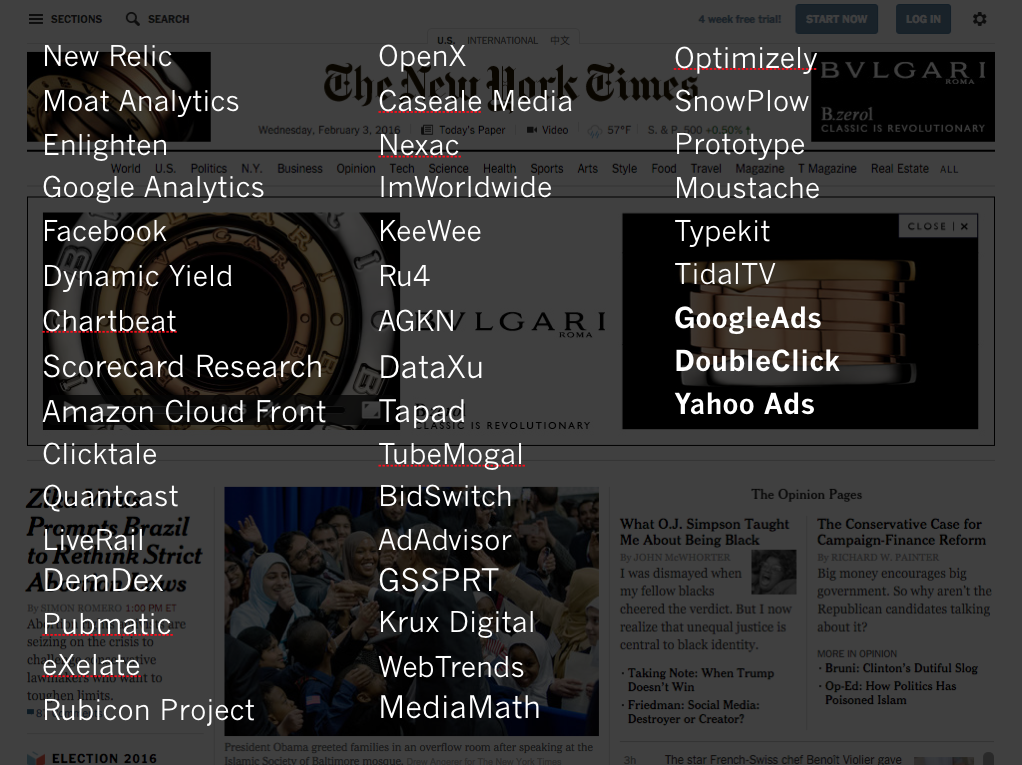
Here’s an example of the site when a non-viewer is viewing it. Good old New York Times. Wednesday, February 3rd. Here’s a basic analysis of what this page is doing when downloading it. While the average homepage these days is about 2 megabytes, The New York Times is about 3.2 megabytes and takes approximately 20 seconds to download. About a third of that download is images and another third, as you can see, is JavaScript, so I wanted to find out a little bit more.
What is all that JavaScript doing? What could The New York Times, which supposedly is the most trusted news site on the planet, put that in quotes, be doing with 1.2 megabytes of JavaScript?
In looking at all these scripts, I kind of felt like I was being in an episode of Lost. I’ll read to you a little bit about what I found and you can kind of see on the screen just some of the tools that are being downloaded. The JavaScript being downloaded are parcelization tools, audience building tools, market research solutions, content delivery services, visualization behaviour tools, and audience measurement tools. There’s something called LiveRail, which is Facebook’s monetization platform. There’s an audience manager application, a marketing automation platform, a unified customer data application, there are advertising automation tools, a unified advertising monetization platform, no idea what that is, an online advertising exchange, something called Nexac, which is totally mysterious and creates these weird, suspicious redirects.
There’s knowledge and data delivery services, third party cookies, marketing and analytics, media activation tools and there’s also a pinpoint advertising tool, which identifies individuals. There’s a programmatic cross-channel campaign orchestration tool, which I still don’t know what that is either, and something called a real-time programmatic ecosystem solution.
There are also numerous web font resources and advertisements from a whole pack of companies. You get the point. There’s just a lot being downloaded. How much of that data is being used and analyzed? We don’t know.
CNN
Here’s another example of a news website. This is the fourth most popular news site. This is CNN. From a general user experience perspective, I like the typography. I think there’s clear navigation. The stories on the left are pretty hard to figure out, and a little bit hard to navigate. More importantly, I want to show you that the CNN site, while not huge, is a 3.7 megabyte download, mostly consisting of images and it takes 20 seconds to download on a desktop. That is a considerable amount of time, and it’s the images that take the most time. Most of these images are unoptimized, which means that 95 million people per month are downloading these huge, fat image files, every month, every day, every second, creating these huge energy demands on servers and on the planet.
Interestingly, I just wanted to highlight for you the tracking ad from Green Geeks. Almost all the news sites I visited are serving me ads that are relevant to my “interests”.
Mail Online
Here’s the Mail Online. This is number 8 in the world in terms of numbers of online readers. From a usability perspective it’s not the worst design, but the headline reaching across 3 lines, I think, is as bizarre as the headline itself.
Here’s again the interesting piece of this. The Mail Online is made up of 82 percent images. This is an astounding amount of data to be sent across the web each day. As you can see, it’s 6.7 megabytes of images. I counted up how many images the homepage has and the page source indicates almost 600 images. The site is littered with photos mostly, and other types of illustrations and gifs. Most of them could be furthered optimized to reduce download speed and decrease the amount of energy being used by the servers.
According to webpagetest.com, which I use to generate a lot of these numbers, those 6.7 megabytes of images could be reduced to a minimum of 4.6 megabytes, a savings of about one third, and I actually think it could be pushed a little further. Here’s a quick pie chart just showing how much of this website is made up of images.
Forbes
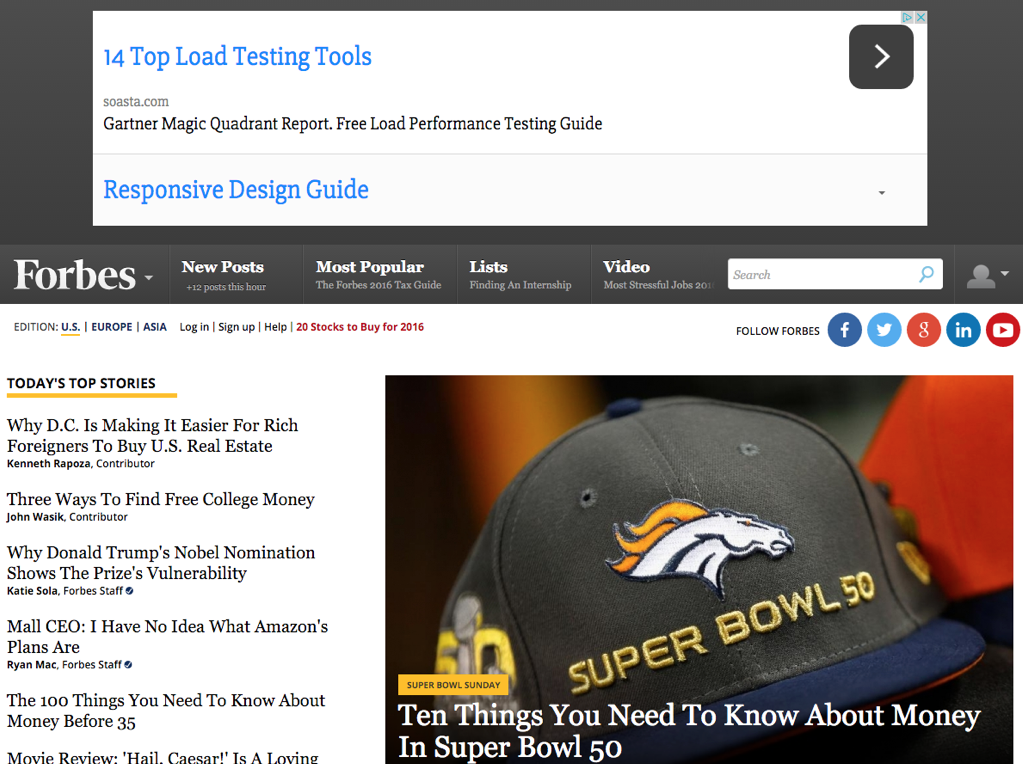
This kind of blew me away. Here’s Forbes.com. This is a heavily traffic news site. It’s not a newspaper site but it is an online business site that a lot of people visit. The question for me is how is this acceptable? This is from a pure usability perspective. We have a banner ad at the top taking over almost the whole third of the site, not to mention when you get to a Forbes page, from a general usability perspective, again, you’re often delayed from actually visiting the content, until you see a quote.
The company has 45 million viewers each month. I wanted to show you on their own site, they do give you an indication of the type of information that they’re gathering about their readers. Again, this is a publicly available screenshot or data from Forbes.com. Very powerful stuff. This is mostly served up from the scripts that are being downloaded to our screens. They would not know this importantly from just the print edition of their magazine.
I’m mostly amazed at how they know the income level of their visitors. 45% had a household income of more than 100,000 dollars and they’ve had 88,000 shares in the past 24 hours. That’s huge. As companies increasingly recognize the amount of data that they can gather about us, the number of calls to servers will also increase, and our privacy will likely decrease.
The Huffington Post
Here’s another interesting site for me. This is Huffington Post. Most of you probably see it or have read it. It’s the fourth largest news site in the world, right after Yahoo, ABC News, CNN and NBC News. Interesting, the website, as you’ll see in a minute, is very well optimized, despite the number of photos and stories indicated. I’m just going to walk you through it. Here’s all the content on this crazy homepage. More content. More content. Still more content. More content and yet more content. Some more content and some more and some more and some more. I don’t know how many people are going to get to the bottom of this page but I went all the way down. Here’s almost the bottom of the page and here is the footer.
What you just experienced is the Huffington Post home page in the United States. It’s a huge, scrolling, crazy thing, but amazingly, shockingly to me, it’s fairly lightweight. From a development side, Huffington Post is doing a lot with very little. The homepage is 4 megabytes and takes 12 seconds to download the entirety. It’s got about 260 images but they’re mostly small and they’re mostly very well optimized. The entire platform of Huffington Post worldwide is 207 million unique views per month. That is a lot. 95 million of those are in the U.S.
USA Today

Here’s a little bit on the other side of the equation. This is USA Today. As you can see, the homepage doesn’t load the news at all. It’s loading a high definition video. I don’t even know what it’s for. I can’t remember. Maybe Disneyland or something. Instead it shows this high resolution video and plays automatically until you click off of it. Increasingly, as I’ll show you in a few minutes, news organizations are seeing video as a replacement for banner ads.

Here’s the stats on that site. 40 second download, 15.5 megabytes total, 11.5 megabytes is video, so really tremendous amount of energy is being used for 81 million people every single month.
Drudge Report
On the other side of the equation is this news site, and believe it or not, Drudge Report is still around. I was surprised myself. Even harder to believe, it looks exactly the same as it did back in 1995 when it launched. Drudge Report has an amazing Alexa rank of 634 and while I don’t agree with Drudge’s politics or editorial policies, I really dig the general approach to minimalist design, and it’s built entirely in unscripted HTML. Here it is. It’s 11 seconds download, .9 megabytes in weight. Most of it is in scripts and as you can see on the right, these scripts are doing all kinds of analytics and tracking to keep the publication in business, at least from their perspective. Very lightweight. 16 million people are viewing this page per month.
Exclusive, Not Intrusive
This leads to a little bit of a final part of the conversation. For me, most of the larger news sites out there are, as you can see, bloated, intrusive or JavaScript laden, image heavy and video rich, and they could use some UX streamlining, but it doesn’t have to be that way. Whether all these videos and JavaScript are necessary from a business perspective, I don’t think so and I doubt it, and from a usability and sustainability perspective, they’re not doing anybody any favours.
As I say, I think there are other ways.
Daring Fireball
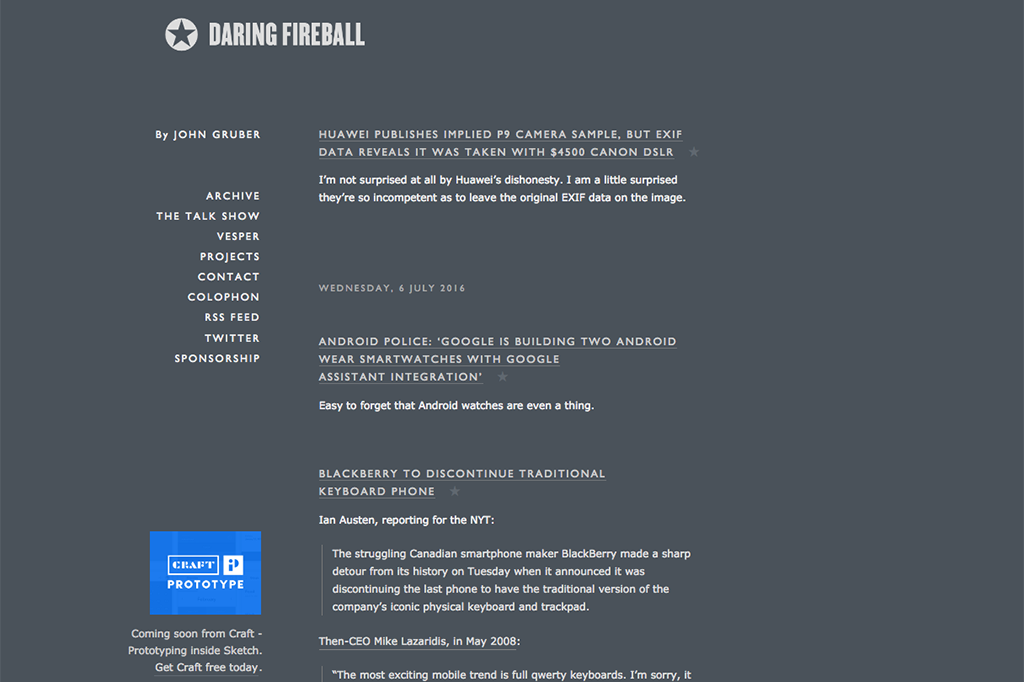
One approach… This is one of my favourite websites. It’s a blog, it’s not a news site, but it’s got news content, it’s Daring Fireball, and I’ve been following John Gruber forever. Huge fan of his writing and his presentation, and he makes very good money thanks to something called the Deck Network. This network’s been around for a while. On this network, advertising is very small and very exclusive. At 120 pixels by 90 pixels tall, or 240 by 180 for Retina, they’re exclusive without being intrusive, and the exclusivity of the ads is part of the attraction. The pricing of the Deck Network ads—and Daring Fireball is on that network—is $7,700 U.S. per month, per slot.
Interestingly, for me, the approximate weight of the ad is 25k, so it’s 25 kilobytes of ad space being served up to millions of visitors. The publisher makes money, the ad network makes money, readers are treated well and not bombarded with ads and the servers aren’t pushing greenhouse gas into the atmosphere in massive amounts. Here’s an analysis of it. 2 second download, the whole page is .1 megabytes, and there’s literally nothing there except great content to read. I’m not saying that every single media site can take on this format, but I think a few can and still be profitable.
The New York Times, Reimagined

I took the liberty of seeing what would happen if The New York Times took on a Deck Network approach using only exclusive quote-unquote advertising to reach audiences in a non-intrusive way. This is what I came up with. Not extremely different from the old site, but here you have a larger and clearer block of advertising content at the top right, and the idea is that The New York Times would exclusively provide small amounts of very, very critical advertising to its audiences and put a premium on it. On a subpage we could see the top, again, uses this exclusive network at the top and the right column we have more details about the campaign.
Essentially what I’m proposing here is that the publisher allows an advertiser to own the site and provide multiple opportunities for the visitor to engage without exclusive content or advertising. I think the Deck Network has something here that we could all learn from.
Numbers
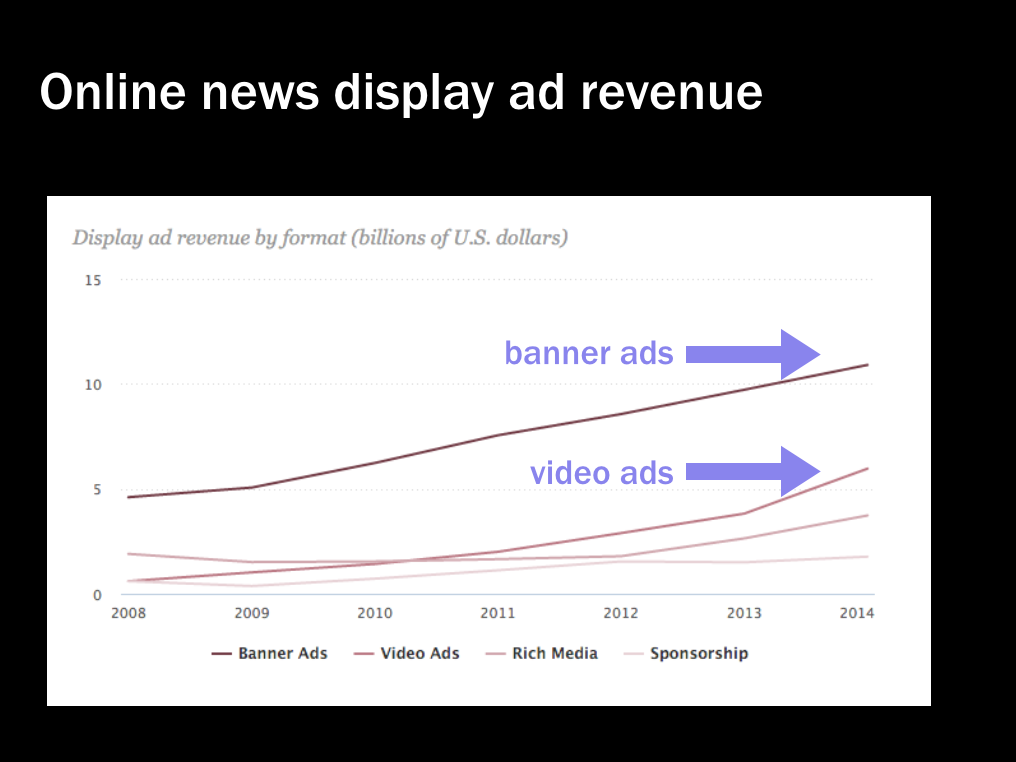
I just want to present a couple numbers here in terms of news online over the past few years. Here are the top 10 news sites as of this month, February 2016. These stats are derived from a number of sources including Alexa global traffic rank, Compete and Quancast. If we add up the number of visitors to all these sites, we get a staggering 870 million visitors per month. That is a lot of data coming down the pipes.
Here’s another quick stat I found interesting. According to the Pew Research Center, banner ads still dominate online news, but video ads are catching up very quickly. You can see that spike between 2013 and 2014. Video display ad spending is growing faster than any other display category. It was up 56% in 2014.
I’ll move quickly through these next. Many of you know the Click Clean scorecard that was mentioned earlier today a few times. You’re probably wondering how much energy are these online news sites actually using. Very hard to figure out, but if we look at just this Click Clean scorecard which is essentially an extension that you can install in Chrome, you get a quick snapshot of who is and who isn’t using green energy. Yahoo is doing a pretty good job. Huffington Post, not horrible, and then the others are essentially failing. A few of the other sites I’ve looked at, there’s no record or no indication of how well they’re doing.
What do we do? What do we do with all this information? What are the things we can learn from this? We obviously want news and we love our news and news is critical to the success of civil society, so for publishers, this kind of dovetails again with James’s saying earlier, reducing image sizes is key.
As you could see with Huffington Post, there are a lot of ways to reduce image sizes either manually or on a server. Images can be saved at much lower resolution and still look pretty good. Video should be used sparingly and should be used at the discretion and the click of the visitor, not automatically.
Publishers Supporting a Sustainable Web
Think about developing an exclusive ad network. I’m pretty convinced it will work for some companies. In fact, I myself have been kicking around the idea of starting a little ad network like the Deck for sustainability folks, and if you’re interested in that, let me know. I’d be happy to talk with you about it at some point.
Finally, there’s green hosting. Hosting powered by renewable energy, as we’re going to hear again and again, is really important at an enterprise level where newspapers are. It’s getting there. Renewable energy is going to be the way to go for large sites like news online.
Readers Supporting Online News
What can we do as readers? There are a few things you can do to help reduce your bandwidth when you’re reading a news site. Keep your page loads quicker. Send a message to companies. The big things are, first, AdBlock Plus. It’s a really easy one if you actually want to be served less advertising content on news websites. It’s a little extension on your browser,which prevents ads and malware and tracking software, and this extension is used by 50 million people right now.
There’s good old RSS. Google almost got rid of it when they lost the RSS reader in 2013 but it’s not dead by any means and RSS will still get you news feeds very quickly and easily without all the clutter. There’s still some excellent RSS readers out there and I would encourage you to check them out.
Finally there’s good old subscribe, and I think essentially if you really wanted to support local, international, and alternative news and have a say in a newspaper’s operations, probably the best solution is going to be to find a newspaper, online journal or a whole slew of them that you like, and pay them. Content does not come cheaply and we do ultimately have to pay the folks that are providing the content we enjoy.
Thank You
That is the end of my presentation. I just want to say a big thanks to James Christie and Jen Briselli for having me speak today. Big thanks to Tim Frick for introducing me to the Sustainable UX conference, and Tim’s talk is coming up, so I hope you all stick around. I want to do a big plug for his talk, his presentation. If you have any questions or thoughts or feedback, I’d love to hear from you. Thank you very much.

